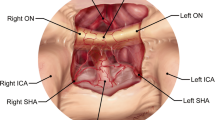Abstract
Purpose
Hydrocephalus-related symptoms are mostly improved after successful endoscopic third ventriculostomy (ETV). However, visual symptoms can be different. This study was focused on visual symptoms. We analyzed the magnetic resonance images (MRI) of the orbit and visual outcomes.
Methods
From August 2006 to November 2016, 50 patients with hydrocephalus underwent ETV. The male-to-female ratio was 33:17, and the median age was 61 years (range, 5–74 years). There were 18 pediatric and 32 adult patients. Abnormal orbital MRI findings included prominent subarachnoid space around the optic nerves and vertical tortuosity of the optic nerves. We retrospectively analyzed clinical symptoms, causes of hydrocephalus, ETV success score (ETVSS), ETV success rate, ETV complications, orbital MRI findings, and visual impairment score (VIS).
Results
The median duration of follow-up was 59 months (range, 3–113 months). The most common symptoms were headache, vomiting, and gait disturbance. Visual symptoms were found in 6 patients (12%). The most common causes of hydrocephalus were posterior fossa tumor in 13 patients, pineal tumor in 12, aqueductal stenosis in 8, thalamic malignant glioma in 7, and tectal glioma in 4. ETVSS was 70 in 3 patients, 80 in 34 patients, and 90 in 13 patients. ETV success rate was 80%. ETVSS 70 showed the trend in short-term survival compared to ETVSS 90 and 80. ETV complications included epidural hematoma requiring operation in one patient, transient hemiparesis in two patients, and infection in two patients. Preoperative abnormal orbital MRI findings were found in 18 patients and postoperative findings in 7 patients. Four of six patients with visual symptoms had abnormal MR findings. Three patients did not show VIS improvement, including two with severe visual symptoms.
Conclusions
Patients with severe visual impairment were found to have bad outcomes. The visual symptoms related with increased intracranial pressure should be carefully monitored and controlled to improve outcomes.





Similar content being viewed by others
References
Garcia LG, Lopez BR, Botella GI, Paez MD, da Rosa SP, Rius F, Sanchez MA (2012) Endoscopic Third Ventriculostomy Success Score (ETVSS) predicting success in a series of 50 pediatric patients. Are the outcomes of our patients predictable? Childs Nerv Syst 28:1157–1162
Kulkarni AV, Drake JM, Mallucci CL, Sgouros S, Roth J, Constantini S, Canadian Pediatric Neurosurgery Study G (2009) Endoscopic third ventriculostomy in the treatment of childhood hydrocephalus. J Pediatr 155(254–259):e251
Furlanetti LL, Santos MV, de Oliveira RS (2012) The success of endoscopic third ventriculostomy in children: analysis of prognostic factors. Pediatr Neurosurg 48:352–359
Deopujari CE, Karmarker VS, Shaikh ST (2017) Endoscopic third ventriculostomy: success and failure. J Korean Neurosurg Soc 60(3):306–314
Schirmer CM, Hedges TR 3rd (2007) Mechanisms of visual loss in papilledema. Neurosurg Focus 23:E5
Zeiner HK, Prigatano GP, Pollay M, Biscoe CB, Smith RV (1985) Ocular motility, visual acuity and dysfunction of neuropsychological impairment in children with shunted uncomplicated hydrocephalus. Childs Nerv Syst 1:115–122
Andersson S, Hellstrom A (2009) Abnormal optic disc and retinal vessels in children with surgically treated hydrocephalus. Br J Ophthalmol 93:526–530
Arroyo HA, Jan JE, McCormick AQ, Farrell K (1985) Permanent visual loss after shunt malfunction. Neurology 35:25–29
Oyama H, Hattori K, Kito A, Maki H, Noda T, Wada K (2012) Visual disturbance following shunt malfunction in a patient with congenital hydrocephalus. Neurol Med Chir (Tokyo) 52:835–838
Kulkarni AV, Drake JM, Kestle JR, Mallucci CL, Sgouros S, Constantini S, Canadian Pediatric Neurosurgery Study G (2010) Predicting who will benefit from endoscopic third ventriculostomy compared with shunt insertion in childhood hydrocephalus using the ETV Success Score. J Neurosurg Pediatr 6:310–315
Passi N, Degnan AJ, Levy LM (2013) MR imaging of papilledema and visual pathways: effects of increased intracranial pressure and pathophysiologic mechanisms. AJNR Am J Neuroradiol 34:919–924
Fahlbusch R, Schott W (2002) Pterional surgery of meningiomas of the tuberculum sellae and planum sphenoidale: surgical results with special consideration of ophthalmological and endocrinological outcomes. J Neurosurg 96:235–243
Rudolph D, Sterker I, Graefe G, Till H, Ulrich A, Geyer C (2010) Visual field constriction in children with shunt-treated hydrocephalus. J Neurosurg Pediatr 6:481–485
Sunil M, Payne C, Panda M (2011) Transient binocular visual loss: a rare presentation of ventriculoperitoneal shunt malfunction. BMJ Case Rep 2011: bcr1020114929
Carruth BP, Bersani TA, Hurley PE, Ko MW (2010) Visual improvement after optic nerve sheath decompression in a case of congenital hydrocephalus and persistent visual loss despite intracranial pressure correction via shunting. Ophthal Plast Reconstr Surg 26(4):297–298
3r d RCN, Proctor BL, Baker RS, Pittman T (2006) Prevention of visual loss caused by shunt failure: a potential role for optic nerve sheath fenestration. Report of three cases. J Neurosurg 104(2 Suppl):149–151
Imamura Y, Mashima Y, Oshitari K, Oguchi Y, Momoshima S, Shiga H (1996) Detection of dilated subarachnoid space around the optic nerve in patients with papilloedema using T2 weighted fast spin echo imaging. J Neurol Neurosurg Psychiatry 60:108–109
Brodsky MC, Vaphiades M (1998) Magnetic resonance imaging in pseudotumor cerebri. Ophthalmology 105:1686–1693
Hiyama T, Masumoto T, Shiigai M, Akutsu H, Matsumura A, Minami M (2015) Optic chiasmal edema observed on T2-weighted MR images: a reversible finding in obstructive hydrocephalus. Jpn J Radiol 33:140–145
Suzuki H, Takanashi J, Kobayashi K, Nagasawa K, Tashima K, Kohno Y (2001) MR imaging of idiopathic intracranial hypertension. AJNR Am J Neuroradiol 22:196–199
Acknowledgements
This study was supported by the Basic Science Research Program through the National Research Foundation of Korea (NRF), funded by the Ministry of Science, ICT, & Future Planning (2017R1A1A1A05001020).
Author information
Authors and Affiliations
Corresponding author
Ethics declarations
Conflict of interest
The authors declare no conflicts of interest.
Rights and permissions
About this article
Cite this article
Jung, JH., Chai, YH., Jung, S. et al. Visual outcome after endoscopic third ventriculostomy for hydrocephalus. Childs Nerv Syst 34, 247–255 (2018). https://doi.org/10.1007/s00381-017-3626-4
Received:
Accepted:
Published:
Issue Date:
DOI: https://doi.org/10.1007/s00381-017-3626-4




